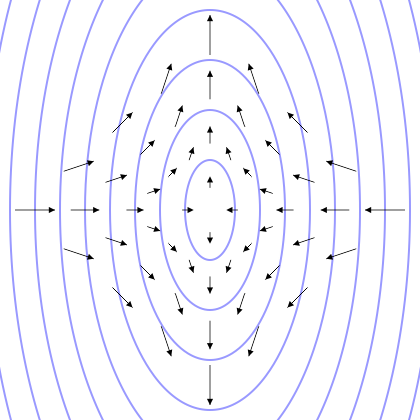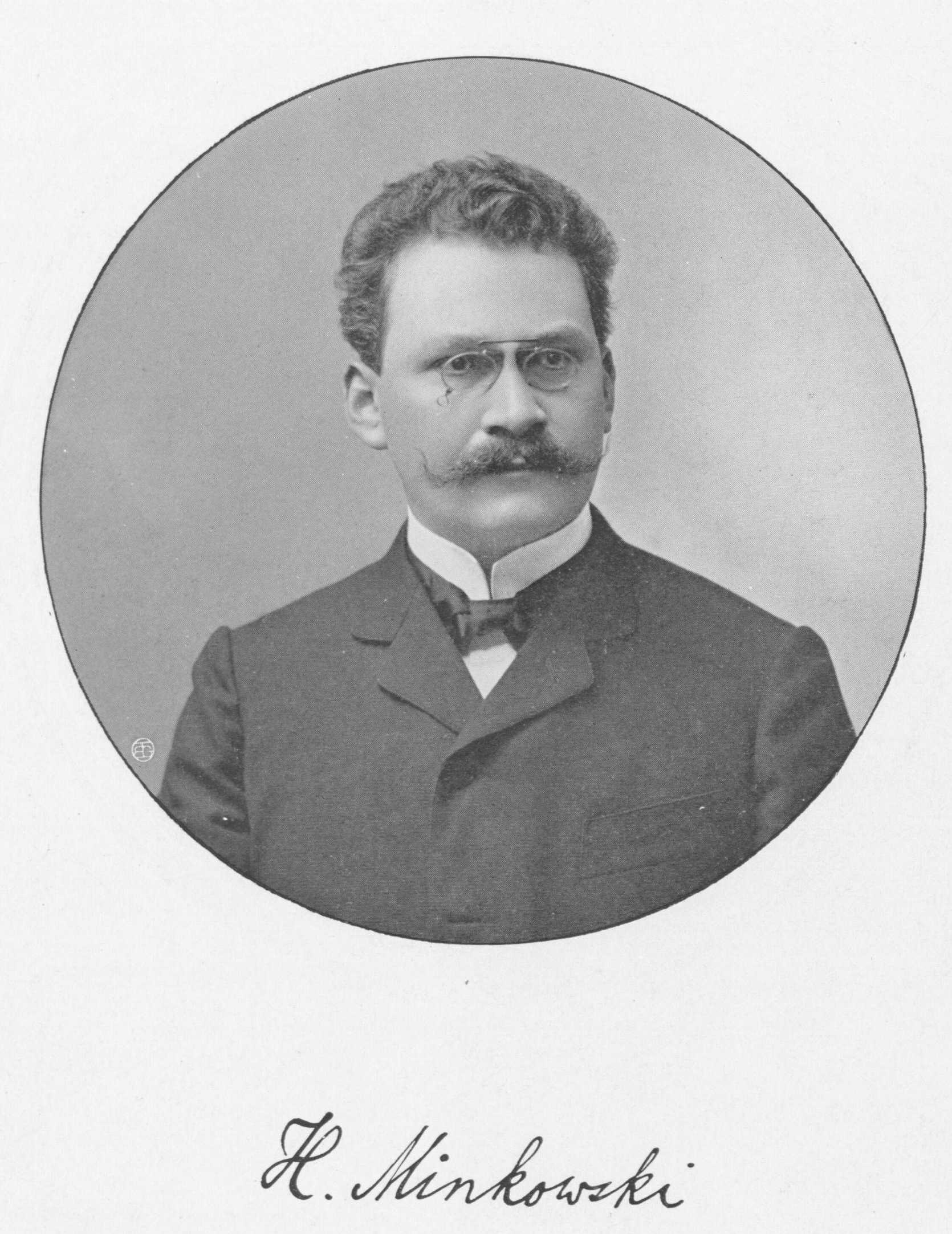|
Einstein's Field Equations
In the general theory of relativity, the Einstein field equations (EFE; also known as Einstein's equations) relate the geometry of spacetime to the distribution of matter within it. The equations were published by Albert Einstein in 1915 in the form of a tensor equation which related the local ' (expressed by the Einstein tensor) with the local energy, momentum and stress within that spacetime (expressed by the stress–energy tensor). Analogously to the way that electromagnetic fields are related to the distribution of charges and currents via Maxwell's equations, the EFE relate the spacetime geometry to the distribution of mass–energy, momentum and stress, that is, they determine the metric tensor of spacetime for a given arrangement of stress–energy–momentum in the spacetime. The relationship between the metric tensor and the Einstein tensor allows the EFE to be written as a set of nonlinear partial differential equations when used in this way. The solutions of t ... [...More Info...] [...Related Items...] OR: [Wikipedia] [Google] [Baidu] |
General Relativity
General relativity, also known as the general theory of relativity, and as Einstein's theory of gravity, is the differential geometry, geometric theory of gravitation published by Albert Einstein in 1915 and is the current description of gravitation in modern physics. General theory of relativity, relativity generalizes special relativity and refines Newton's law of universal gravitation, providing a unified description of gravity as a geometric property of space and time in physics, time, or four-dimensional spacetime. In particular, the ''curvature of spacetime'' is directly related to the energy and momentum of whatever is present, including matter and radiation. The relation is specified by the Einstein field equations, a system of second-order partial differential equations. Newton's law of universal gravitation, which describes gravity in classical mechanics, can be seen as a prediction of general relativity for the almost flat spacetime geometry around stationary mass ... [...More Info...] [...Related Items...] OR: [Wikipedia] [Google] [Baidu] |
Inertia
Inertia is the natural tendency of objects in motion to stay in motion and objects at rest to stay at rest, unless a force causes the velocity to change. It is one of the fundamental principles in classical physics, and described by Isaac Newton in his Newton%27s_laws_of_motion#First, first law of motion (also known as The Principle of Inertia). It is one of the primary manifestations of mass, one of the core quantitative properties of physical systems. Newton writes: In his 1687 work ''Philosophiæ Naturalis Principia Mathematica'', Newton defined inertia as a property: History and development Early understanding of inertial motion Joseph NeedhamProfessor John H. Lienhard points out the Mozi (book), Mozi – based on a Chinese text from the Warring States period (475–221 BCE) – as having given the first description of inertia. Before the European Renaissance, the prevailing theory of motion in western philosophy was that of Aristotle (384–322 BCE). On the surface ... [...More Info...] [...Related Items...] OR: [Wikipedia] [Google] [Baidu] |
Cosmological Constant
In cosmology, the cosmological constant (usually denoted by the Greek capital letter lambda: ), alternatively called Einstein's cosmological constant, is a coefficient that Albert Einstein initially added to his field equations of general relativity. He later removed it; however, much later it was revived to express the energy density of space, or vacuum energy, that arises in quantum mechanics. It is closely associated with the concept of dark energy. Einstein introduced the constant in 1917. to counterbalance the effect of gravity and achieve a static universe, which was then assumed. Einstein's cosmological constant was abandoned after Edwin Hubble confirmed that the universe was expanding. From the 1930s until the late 1990s, most physicists agreed with Einstein's choice of setting the cosmological constant to zero. That changed with the discovery in 1998 that the expansion of the universe is accelerating, implying that the cosmological constant may have a positive valu ... [...More Info...] [...Related Items...] OR: [Wikipedia] [Google] [Baidu] |
Gravitational Waves
Gravitational waves are oscillations of the gravitational field that travel through space at the speed of light; they are generated by the relative motion of gravitating masses. They were proposed by Oliver Heaviside in 1893 and then later by Henri Poincaré in 1905 as the gravitational equivalent of electromagnetic waves. In 1916, Albert Einstein demonstrated that gravitational waves result from his general theory of relativity as ripples in spacetime. Gravitational waves transport energy as gravitational radiation, a form of radiant energy similar to electromagnetic radiation. Newton's law of universal gravitation, part of classical mechanics, does not provide for their existence, instead asserting that gravity has instantaneous effect everywhere. Gravitational waves therefore stand as an important relativistic phenomenon that is absent from Newtonian physics. Gravitational-wave astronomy has the advantage that, unlike electromagnetic radiation, gravitational waves are not a ... [...More Info...] [...Related Items...] OR: [Wikipedia] [Google] [Baidu] |
Linearized Gravity
In the theory of general relativity, linearized gravity is the application of perturbation theory to the metric tensor that describes the geometry of spacetime. As a consequence, linearized gravity is an effective method for modeling the effects of gravity when the gravitational field is weak. The usage of linearized gravity is integral to the study of gravitational waves and weak-field gravitational lensing. Weak-field approximation The Einstein field equation (EFE) describing the geometry of spacetime is given as : R_ - \fracRg_ = \kappa T_ where R_ is the Ricci tensor, R is the Ricci scalar, T_ is the energy–momentum tensor, \kappa = 8 \pi G / c^4 is the Einstein gravitational constant, and g_ is the spacetime metric tensor that represents the solutions of the equation. Although succinct when written out using Einstein notation, hidden within the Ricci tensor and Ricci scalar are exceptionally nonlinear dependencies on the metric tensor that render the prospect of fin ... [...More Info...] [...Related Items...] OR: [Wikipedia] [Google] [Baidu] |
Minkowski Space
In physics, Minkowski space (or Minkowski spacetime) () is the main mathematical description of spacetime in the absence of gravitation. It combines inertial space and time manifolds into a four-dimensional model. The model helps show how a spacetime interval between any two events is independent of the inertial frame of reference in which they are recorded. Mathematician Hermann Minkowski developed it from the work of Hendrik Lorentz, Henri Poincaré, and others said it "was grown on experimental physical grounds". Minkowski space is closely associated with Einstein's theories of special relativity and general relativity and is the most common mathematical structure by which special relativity is formalized. While the individual components in Euclidean space and time might differ due to length contraction and time dilation, in Minkowski spacetime, all frames of reference will agree on the total interval in spacetime between events.This makes spacetime distance an inva ... [...More Info...] [...Related Items...] OR: [Wikipedia] [Google] [Baidu] |
Metric Expansion Of Space
The expansion of the universe is the increase in distance between gravitationally unbound parts of the observable universe with time. It is an intrinsic expansion, so it does not mean that the universe expands "into" anything or that space exists "outside" it. To any observer in the universe, it appears that all but the nearest galaxies (which are bound to each other by gravity) move away at speeds that are proportional to their distance from the observer, on average. While objects cannot move faster than light, this limitation applies only with respect to local reference frames and does not limit the recession rates of cosmologically distant objects. Cosmic expansion is a key feature of Big Bang cosmology. It can be modeled mathematically with the Friedmann–Lemaître–Robertson–Walker metric (FLRW), where it corresponds to an increase in the scale of the spatial part of the universe's spacetime metric tensor (which governs the size and geometry of spacetime). Within ... [...More Info...] [...Related Items...] OR: [Wikipedia] [Google] [Baidu] |
Rotating Black Hole
A rotating black hole is a black hole that possesses angular momentum. In particular, it rotates about one of its axes of symmetry. All currently known celestial objects, including planets, stars (Sun), galaxies, and black holes, spin about one of their axes. Types of black holes There are four known, exact, black hole solutions to the Einstein field equations, which describe gravity in general relativity. Two of those rotate: the Kerr and Kerr–Newman black holes. It is generally believed that every black hole decays rapidly to a stable black hole; and, by the no-hair theorem, that (except for quantum fluctuations) stable black holes can be completely described at any moment in time by these 11 numbers: * mass–energy equivalence, mass–energy ''M'', * linear momentum ''P'' (three components), * angular momentum ''J'' (three components), * position (vector), position ''X'' (three components), * electric charge ''Q''. These numbers represent the conserved attributes of ... [...More Info...] [...Related Items...] OR: [Wikipedia] [Google] [Baidu] |
Exact Solutions In General Relativity
In general relativity, an exact solution is a (typically closed form) solution of the Einstein field equations whose derivation does not invoke simplifying approximations of the equations, though the starting point for that derivation may be an idealized case like a perfectly spherical shape of matter. Mathematically, finding an exact solution means finding a Lorentzian manifold equipped with tensor fields modeling states of ordinary matter, such as a fluid, or classical non-gravitational fields such as the electromagnetic field. Background and definition These tensor fields should obey any relevant physical laws (for example, any electromagnetic field must satisfy Maxwell's equations). Following a standard recipe which is widely used in mathematical physics, these tensor fields should also give rise to specific contributions to the stress–energy tensor T^. (A field is described by a Lagrangian, varying with respect to the field should give the field equations and varyin ... [...More Info...] [...Related Items...] OR: [Wikipedia] [Google] [Baidu] |
Spacetime Symmetries
Spacetime symmetries are features of spacetime that can be described as exhibiting some form of symmetry. The role of symmetry in physics is important in simplifying solutions to many problems. Spacetime symmetries are used in the study of exact solutions of Einstein's field equations of general relativity. Spacetime symmetries are distinguished from internal symmetries. Physical motivation Physical problems are often investigated and solved by noticing features which have some form of symmetry. For example, in the Schwarzschild solution, the role of spherical symmetry is important in deriving the Schwarzschild solution and deducing the physical consequences of this symmetry (such as the nonexistence of gravitational radiation in a spherically pulsating star). In cosmological problems, symmetry plays a role in the cosmological principle, which restricts the type of universes that are consistent with large-scale observations (e.g. the Friedmann–Lemaître–Robertson–Walker ... [...More Info...] [...Related Items...] OR: [Wikipedia] [Google] [Baidu] |
Speed Of Light
The speed of light in vacuum, commonly denoted , is a universal physical constant exactly equal to ). It is exact because, by international agreement, a metre is defined as the length of the path travelled by light in vacuum during a time interval of second. The speed of light is invariant (physics), the same for all observers, no matter their relative velocity. It is the upper limit for the speed at which Information#Physics_and_determinacy, information, matter, or energy can travel through Space#Relativity, space. All forms of electromagnetic radiation, including visible light, travel at the speed of light. For many practical purposes, light and other electromagnetic waves will appear to propagate instantaneously, but for long distances and sensitive measurements, their finite speed has noticeable effects. Much starlight viewed on Earth is from the distant past, allowing humans to study the history of the universe by viewing distant objects. When Data communication, comm ... [...More Info...] [...Related Items...] OR: [Wikipedia] [Google] [Baidu] |





